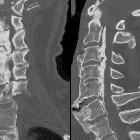Diffuse idiopathische Skeletthyperostose




Diffuse idiopathic skeletal hyperostosis (DISH), also referred to as Forestier disease, is a common condition characterized by bony proliferation at sites of tendinous and ligamentous insertion of the spine affecting elderly individuals. On imaging, it is typically characterized by the flowing ossification of the anterior longitudinal ligament involving the thoracic spine and enthesopathy (e.g. at the iliac crest, ischial tuberosities, and greater trochanters). There is no involvement of the sacroiliac joints.
Epidemiology
DISH most commonly affects the elderly, especially 6th to 7th decades . The estimated frequency in the elderly is ~10% , with a male predominance.
Clinical presentation
The condition is commonly identified as an incidental finding when imaging for other reasons. However, spine stiffness and decreased mobility are referred to as possible symptoms.
Pathology
The etiology of DISH is still unknown. Histopathological features of spinal DISH include :
- focal and diffuse calcification and ossification of the anterior longitudinal ligament
- paraspinal connective tissue and annulus fibrosus
- degeneration of the peripheral annulus fibrosus fibers
- anterolateral extensions of fibrous tissue
- hypervascularity
- chronic inflammatory cellular infiltration
- periosteal new bone formation on the anterior surface of the vertebral bodies
Location
The cervical and thoracic (particularly T7-11 ) spines, in particular, are affected. Additionally, enthesopathy may be identified in the pelvis and extremities.
Associations
Recognized associations include:
- ossification of the posterior longitudinal ligament
- hyperglycemia
- approximately one-third of patients test positive for HLA-B27
Radiographic features
Plain radiograph and CT
Spinal features
- flowing ossifications: florid, flowing ossification along the anterior or right anterolateral aspects of at least four contiguous vertebrae
- disc spaces are usually well preserved
- ankylosis is more common in the thoracic than cervical or lumbar spine
- frequently incomplete
- can have interdigitating areas of protruding disc material in the flowing ossifications
- no sacroiliitis or facet joint ankylosis
Extraspinal features
- enthesopathy of the iliac crest, ischial tuberosities, and greater trochanters
- spur formation in the appendicular skeleton (olecranon, calcaneum, patellar ligament) frequently present
- 'whiskering' enthesophytes
Treatment and prognosis
DISH is generally managed clinically with analgesics and non-steroidal anti-inflammatory drugs when pain and stiffness are related. Possible complications may require specific treatment:
- acute spinal fractures
- rarely dysphagia caused by mechanical compression due to anterior cervical bone production
Differential diagnosis
- ankylosing spondylitis
- syndesmophytes: thinner, form over the annulus, and are vertically oriented ("bamboo spine")
- sacroiliac joint involvement early on and is in the synovial portion (inferior two-thirds)
- osteoporosis is prominent
- degenerative spine disease
- usually has prominent facet and apophyseal joints degenerative changes as well
- disc degenerative changes
- usually, the anterior longitudinal ligament of the thoracic spine is not affected
- retinoid arthropathy
- patients using retinoid acid for skin diseases
- skeletal hyperostosis
- predominantly involves the cervical spine
- fluorosis
- fluorite intoxication due to long-term ingestion
- can cause paraspinal ligament calcification
- if seen in a child, consider juvenile idiopathic arthritis (JIA)
Siehe auch:
und weiter:

 Assoziationen und Differentialdiagnosen zu Diffuse idiopathische Skeletthyperostose:
Assoziationen und Differentialdiagnosen zu Diffuse idiopathische Skeletthyperostose:

